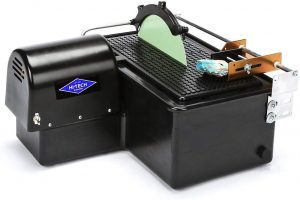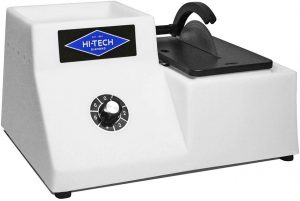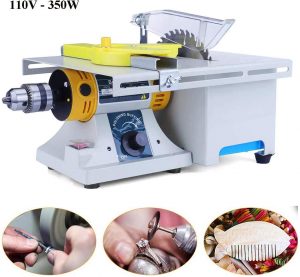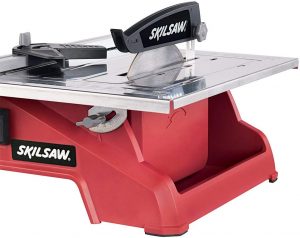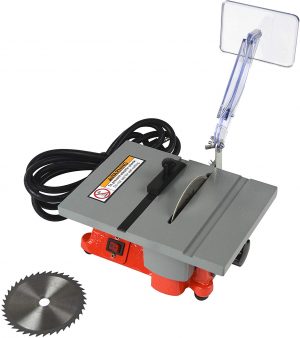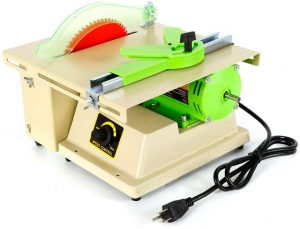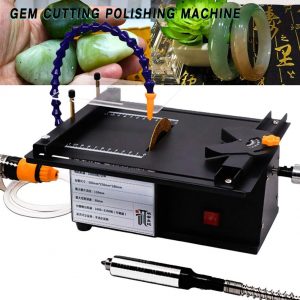Cutting Through the Options: Lapidary Saws for Hobbyists in 2025

There's something almost alchemical about the moment a diamond blade meets rough stone. The water sprays, the motor hums at precisely 1,725 rotations per minute, and suddenly you're not just cutting rock - you're revealing what's been hidden for millions of years. A lapidary saw transforms a dusty chunk of agate or jasper into something that catches light, something that becomes wearable art.
At Modernhaus, we document traditional crafts because they represent something increasingly rare: skills that require patience, materials that demand respect, and the particular satisfaction that comes only from making rather than buying. These aren't hobbies; they're practices worth preserving.
The modern lapidary workshop revolves around this fundamental truth: before you can polish, before you can shape, before you can set a stone into silver or gold, you need to slice through solid rock with mechanical precision. It's a practice that sits somewhere between industrial manufacturing and artistic creation, requiring machines that can deliver both brute force and delicate control.
What separates lapidary saws from their construction-site cousins isn't just the diamond-impregnated blades or the constant water cooling - it's the entire ecosystem built around transforming rough material into something refined. A 10-inch slab saw cutting through a softball-sized piece of rough turquoise operates on the same basic principle as a trim saw making millimeter-precise cuts on a fire opal, yet each serves a distinct purpose in the journey from quarry to jewelry box.
The numbers tell their own story: blade diameters ranging from 4 inches to 10 inches, cutting depths from one inch to nearly four, motor speeds variable from 800 to 3,400 RPM depending on material hardness and desired finish. These specifications translate directly into creative possibilities - whether that's slicing geodes to reveal crystalline interiors, cutting slabs for cabochon production, or trimming facet rough with the kind of precision that wastes nothing of a stone that might cost hundreds of dollars per ounce.
In the current market, American-made machines dominate the serious hobbyist space, with manufacturers like Hi-Tech Diamond producing saws from cross-linked polyethylene that resist both rust and impact damage. Chinese manufacturers have entered with budget options that bundle cutting, grinding, and polishing functions into single units, though documentation quality varies considerably. The price spread - from under $200 to over $1,000 - reflects not just build quality but also the fundamental question every lapidary faces: what exactly are you trying to cut, and how often?
The division between slab saws and trim saws reflects the two-stage reality of lapidary work. Slab saws, typically sporting 10-inch blades, handle the heavy lifting - reducing rough material to workable slices between 1/8 and 1/2 inch thick. These machines run on higher horsepower motors and larger water reservoirs, built for extended cutting sessions through dense material. Trim saws, with their 4 to 6-inch blades, excel at the detail work: squaring up slabs, removing matrix material, cutting preforms for cabochons. The distinction shows up in kerf width too - slab saw blades cut wider paths through stone, accepting some material loss for stability and speed, while trim saw blades minimize waste with thinner kerfs, critical when working with expensive rough like black opal or emerald. The slabs you cut become the starting point for grit progression on the cabbing machine.
| Product Type | Brand | Product |
|---|---|---|
| 10-Inch Slab Saw | Hi-Tech Diamond 10″ Lapidary Slab Saw | 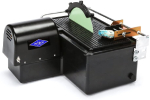 |
| 6-Inch Trim Saw | Hi-Tech Diamond 6″ Lapidary Trim Saw | 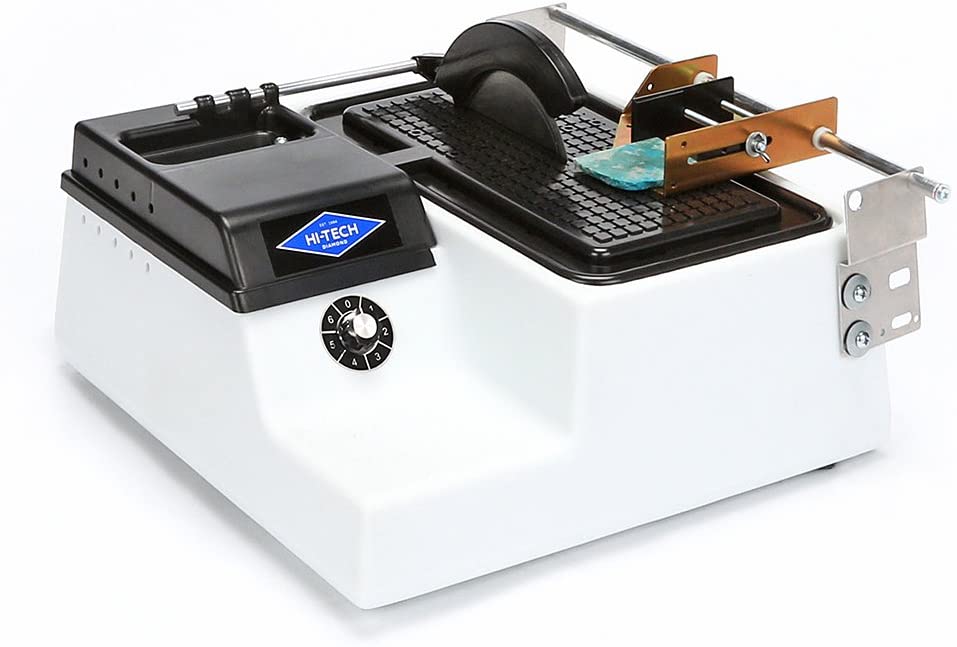 |
| 4/5-Inch Trim Saw | Hi-Tech Diamond 4″/5″ Lapidary Trim Saw | 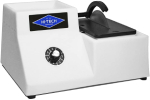 |
| Multi-Function Saw | Mini Table Jewelry Saw with Polishing Lathe | 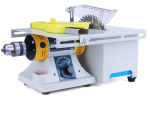 |
| Tile Saw (Lapidary Capable) | SKIL 3540-02 7-Inch Wet Tile Saw | 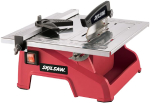 |
The Machines
Hi-Tech Diamond 10″ Lapidary Slab Saw
Hi-Tech Diamond 10″ Lapidary Slab Saw
- 1/3 HP motor at fixed 1,725 RPM
- Cuts material up to 3-3/4 inches high
- 32-ounce water reservoir with drain plug
- Work table: 19-3/4" L x 12" W (removable)
- Includes notched blade (agates/jades) and sintered blade (glass/quartz)
- Cross-linked polyethylene construction
The Hi-Tech Diamond 10-inch represents what American lapidary manufacturing looks like when it prioritizes durability over features. At 1,725 RPM - a speed that sits in the sweet spot between aggressive cutting and blade preservation - this machine operates with the kind of consistency that comes from a fixed-speed 1/3 horsepower motor. No variable speed control means no complexity to fail, no settings to fiddle with, just constant, reliable rotation.
The machine arrives with two distinct blade technologies. The notched rim blade, with its diamond grit pressed into a solid steel core, cuts through agates and jades with the kind of authority that thicker kerfs provide - trading some material loss for stability when pushing through cryptocrystalline quartz or nephrite. The sintered blade operates on a different principle entirely: diamond particles distributed throughout the metal matrix expose fresh cutting surfaces as the blade wears, extending its lifespan considerably when working with glass, topaz, or fine-grained agates.
Cross-linked polyethylene construction sounds like marketing speak until you understand what it means in a workshop environment: complete immunity to rust, resistance to the kind of impacts that happen when a five-pound chunk of jasper slips from wet hands, and surfaces that clean with a garden hose. The 32-ounce water reservoir sits directly beneath the blade, creating a self-contained cooling system that captures runoff through the splash guard. A drain plug eliminates the wrestling match of trying to tip and pour dirty water from a 40-pound machine.
The work table spans 19-3/4 by 12 inches - dimensions that translate to enough space for maneuvering a football-sized piece of rough while maintaining control. That 3-3/4 inch maximum cutting height handles most material that arrives from field collecting or rough dealers. The vise attachment (available as an option) grips material for those who prefer mechanical precision over hand-feeding, particularly relevant when making repeated parallel cuts for bookmatched slabs.
Hi-Tech Diamond 6″ Lapidary Trim Saw
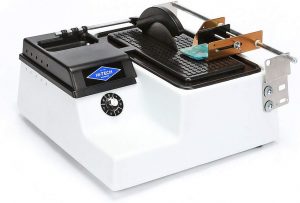
Hi-Tech Diamond 6″ Lapidary Trim Saw
- 1/4 HP motor with variable speed (800-3,400 RPM)
- Cuts material up to 1-3/4 inches thick
- 16-ounce water reservoir
- Work table: 15-1/2" L x 9" W (removable)
- Includes notched blade (minerals) and sintered blade (glass/quartz)
- Available with or without vise attachment
Where the 10-inch slab saw operates like a bulldozer, the 6-inch trim saw functions more like a scalpel. The variable speed control - ranging from 800 to 3,400 RPM - transforms how different materials respond to cutting. Obsidian might demand the slower end of that spectrum to prevent chipping, while dense nephrite jade benefits from higher speeds to maintain cutting efficiency. This flexibility comes from a 1/4 horsepower permanent magnet motor with sealed ball bearings, the same power output as the smaller 4-inch model but distributed across a larger blade diameter.
The dual-blade system mirrors its larger sibling's approach but scaled for detail work. The silver notched diamond blade handles the traditional lapidary materials - turquoise, garnet, corundum, emerald, ruby - while the red sintered blade takes on glass, topaz, and fine-grained agates. The difference becomes apparent in the cutting depth: 1-3/4 inches maximum, which covers most cabochon rough and faceting material that comes pre-slabbed from dealers.
The 16-ounce reservoir might seem modest, but it matches the machine's intended use pattern - shorter cutting sessions focused on precision rather than production. The removable saw table, at 15-1/2 by 9 inches, provides enough real estate for an adjustable rip fence (included) that enables consistent parallel cuts, essential when trimming expensive rough where every millimeter represents dollars lost or saved.
Hi-Tech offers this model with or without the vise attachment, a choice that reflects different working styles. Hand-feeding allows for intuitive curve cutting and quick angle adjustments, while the vise ensures repeatable precision - particularly valuable when creating matched pairs for earrings or cutting calibrated stones for production jewelry work. The same cross-linked polyethylene construction carries through the entire Hi-Tech line, meaning this smaller saw shares its bigger brother's immunity to workshop hazards.
Hi-Tech Diamond 4″/5″ Lapidary Trim Saw
Hi-Tech Diamond 4″/5″ Lapidary Trim Saw
- 1/4 HP motor with variable speed (800-3,400 RPM)
- 4" blade cuts to 1 inch, 5" blade cuts to 1-1/2 inches
- 8-ounce water reservoir
- Work table: 7-1/2" L x 4-3/4" W
- Includes both 4" and 5" silver notched diamond blades
- Ball-bearing motor with sealed bearings
The mathematics of lapidary work often come down to fractions of inches and fragments of carats. The 4/5-inch trim saw occupies the space where precision matters more than power, where a kerf width measured in millimeters can determine whether a piece of Ethiopian opal yields one stone or two. Despite its compact footprint - the work table measures just 7-1/2 by 4-3/4 inches - this machine packs the same 1/4 horsepower motor and variable speed range (800-3,400 RPM) as the 6-inch model.
Two blade sizes ship with this saw, each serving different cutting depths: the 4-inch blade handles material up to one inch thick, while the 5-inch extends that range to 1-1/2 inches. Both are silver notched diamond blades, optimized for the harder materials - turquoise, garnet, corundum, emerald, ruby - that typically arrive in smaller, more valuable parcels. The fine kerf of these smaller blades becomes critical when working with rough that might cost $100 per gram.
The 8-ounce reservoir seems almost toy-like until you consider the typical cutting session with this machine: a few precise cuts through pre-formed rough, perhaps squaring up a piece of tourmaline or removing a inclusion from a sapphire. The spray shield serves double duty, containing the modest water spray while continuously dripping coolant onto the blade - a simple gravity-fed system that requires no pumps or additional complexity.
Hi-Tech's decision to include both blade sizes reflects the reality of small-stone cutting. That extra half-inch of depth between the 4 and 5-inch blades often marks the difference between what can and cannot be cut. A piece of rough that's just slightly too thick for the 4-inch blade doesn't require upgrading to a larger machine - just a blade swap that takes minutes. The same rustproof, impact-resistant polyethylene construction scales down without compromise, creating a machine light enough to store in a drawer but robust enough to handle daily use.
Mini Table Jewelry Saw with Polishing Lathe
Mini Table Jewelry Saw with Polishing Lathe
- Just under 1/2 HP motor (0-10,000 RPM variable)
- Cuts material up to 30mm (1.18 inches) thick
- Includes two cutting blades and buffing wheels
- 42.5-inch flexible shaft attachment
- Accommodates grinding/buffing wheels up to 7 inches
- Angle-adjustable ruler for precision cuts
The TM-2 represents a different philosophy entirely - the Swiss Army knife approach to lapidary equipment. This third-generation Chinese-manufactured machine bundles cutting, grinding, buffing, and carving capabilities into a single unit that costs less than most dedicated trim saws. The motor, at just under 1/2 horsepower, actually exceeds the power output of the Hi-Tech trim saws, though it channels that power across multiple functions rather than optimizing for one.
Variable speed from zero to 10,000 RPM opens up possibilities beyond stone cutting. At the lower speeds, it functions as a traditional lapidary saw, cutting through material up to 30mm thick with the included blades. Crank it up to middle speeds, and those dual mandrels transform it into a grinding station, accepting wheels up to 7 inches in diameter. At maximum velocity, it becomes a polishing lathe capable of bringing cabochons to a mirror finish.
The 42.5-inch flexible shaft attachment might be the most intriguing feature. This snake-like appendage extends the motor's power to handheld tools, enabling detail carving, precision grinding, and access to areas no fixed wheel could reach. It's the kind of addition that turns a basic saw into a complete workstation, particularly relevant for those working in confined spaces or on irregular pieces.
Documentation presents the primary challenge with this machine. The instructions arrive in the kind of English that requires interpretation rather than reading, leaving users to discover optimal settings through experimentation. The angle-adjustable ruler allows for precise miter cuts once you decipher its adjustment mechanism. The ability to run wet or dry adds flexibility - wet for traditional stone cutting, dry for materials like amber or jet that don't play well with water.
Two mandrels mean you can mount different grits simultaneously, eliminating the constant wheel changes that slow down progressive grinding. The included 4-1/4 inch buffing wheels get you started, though the machine's ability to accept larger wheels up to 7 inches suggests room for growth as techniques develop.
SKIL 3540-02 7-Inch Wet Tile Saw
SKIL 3540-02 7-Inch Wet Tile Saw
- 7-inch blade capacity
- Adjustable rip fence with miter gauge
- Bevel capability: 0-45 degrees
- Stainless steel table surface
- Water reservoir cooling system
- Cuts material up to 2 inches thick
Sometimes the best lapidary saw isn't marketed as one at all. The SKIL 3540-02 arrives in the tile aisle of home improvement stores, but swap its tile blade for a quality diamond lapidary blade and it transforms into a capable stone-cutting machine. The 7-inch blade size sits between typical trim and slab saw dimensions, handling material up to 2 inches thick - enough for most agates, jaspers, and quartzes that hobbyists encounter.
The adjustable rip fence with miter gauge brings a level of precision more common in woodworking than lapidary. Combined with the 0-45 degree bevel capability, this saw can execute compound angles that dedicated lapidary saws rarely attempt. These features matter when cutting geometric shapes for intarsia work or creating precise angles for architectural stone projects.
Stainless steel construction on the table surface resists the acidic slurry that develops when cutting certain stones, particularly those with iron content. The water reservoir sits beneath the deck, maintaining blade cooling through a simple gravity-feed system similar to dedicated lapidary saws. No pump means one less component to fail, though it also means no active spray onto the cutting area.
The economics make this saw particularly interesting. At roughly one-third the price of comparable Hi-Tech Diamond saws, it opens lapidary work to those testing the waters before committing to specialized equipment. Add a quality continuous-rim diamond blade designed for lapidary work - available for $30-50 - and you have a functional stone-cutting setup for less than the cost of most trim saws.
The trade-offs appear in the details. No variable speed control means you're locked into whatever RPM the motor delivers. The water system, while functional, lacks the spray shields and directed cooling of purpose-built lapidary saws, potentially creating a messier workspace. The arbor size and blade mounting system, designed for tile blades, might limit options when shopping for specialized lapidary blades.
Additional Options in the Market
The lapidary saw market extends beyond these primary machines, with several other models filling specific niches:
PMC Supplies LLC 4″ Diameter Mini Jeweler's Saw
PMC Supplies LLC 4″ Diameter Mini Jeweler's Saw
At the minimal end of the spectrum, this dry-cutting saw handles material up to 3/4 inch deep. The absence of water cooling limits it to softer materials or brief cutting sessions to prevent blade overheating. The blade guard and eye shield address the safety concerns that come with dry cutting, where material flies rather than washing away. Silver, aluminum, and softer stones like soapstone or alabaster fall within its capabilities. The price point - often under $100 - makes it accessible for those testing whether lapidary work suits them.
MONIPA Mini Table Saw
Another multifunctional machine that accommodates 6-inch blades but ships without lapidary-specific blades. The variable speed range (500-7,000 RPM) and dual-purpose design for cutting and polishing mirror the TM-2's approach. Users report success after sourcing appropriate diamond blades separately, though this adds to the initial investment.
TBvechi 7-Speed Adjustable Gem Jade Cutting Machine
TBvechi 7-Speed Adjustable Gem Jade Cutting Carving Polishing Milling Machine
Marketed specifically for jade work, this machine operates in a narrower speed range (1,600-3,300 RPM) optimized for harder materials. The 4-inch blade limits cutting depth to one inch, but the integrated carving and polishing capabilities expand its utility beyond simple cutting. The seven-speed settings provide more granular control than simple variable speed, allowing users to dial in specific RPMs for different operations.
The Reality of Lapidary Sawing
Every lapidary saw represents a series of trade-offs. Blade diameter determines maximum cutting depth but also kerf width and material waste. Motor power enables cutting harder materials but increases machine weight and cost. Variable speed provides flexibility but introduces mechanical complexity. Water cooling prevents blade damage and dust but creates cleanup requirements.
The American manufacturers like Hi-Tech Diamond have chosen durability and specialization - machines built to do one thing reliably for decades. Their cross-linked polyethylene construction might not win design awards, but it survives the reality of workshop use: accidental impacts, constant moisture, and the corrosive slurry that develops when iron-bearing stones meet diamond blades.
Chinese manufacturers have taken the opposite approach, bundling multiple functions into single machines at aggressive price points. The documentation might require interpretation and the build quality varies, but these machines open lapidary work to those unwilling or unable to invest in specialized equipment for each operation.
Between specialized lapidary saws and adapted tile saws lies a practical middle ground. A SKIL tile saw with a quality lapidary blade might not match a Hi-Tech's precision, but it cuts stones effectively while remaining useful for home improvement projects. This dual-purpose capability matters for hobbyists with limited workshop space or those unsure about long-term commitment to lapidary work.
The progression from rough rock to finished cabochon typically requires multiple saw types - or creative workarounds with a single machine. A 10-inch slab saw reduces rough material to workable slices, but its thick kerf wastes precious material when trimming small stones. A 4-inch trim saw excels at detail work but can't handle the initial breakdown of larger rough. The multi-function machines attempt to bridge this gap with varying degrees of success.
Material costs often dictate equipment choices more than initial purchase price. When working with common agates or jaspers selling for dollars per pound, a thick kerf and some material waste barely register. But when trimming black opal rough at $500 per gram, every millimeter of kerf width represents significant loss. The precision of smaller trim saws with thin blades suddenly justifies their place in the workshop. Precision cutting becomes even more important when you're working with expensive rough that requires careful dopping for cabbing.
The evolution of synthetic diamond technology continues to improve blade performance and longevity. Sintered blades, with diamond particles distributed throughout the metal matrix, maintain cutting ability as they wear. Electroplated blades offer extremely thin kerfs for minimal waste. Notched rim blades provide aggressive cutting for production work. Each technology serves specific needs within the lapidary process. Understanding blade longevity across different stone types helps predict replacement costs and choose appropriate blades for your materials.
Workshop reality extends beyond the saw itself. Water management - containing spray, filtering slurry, preventing rust - consumes more time than actual cutting. Blade maintenance, from cleaning to periodic dressing, determines cutting efficiency and blade life. The workspace around the saw, including adequate lighting and ventilation, affects both safety and precision. A well-planned lapidary workshop setup addresses these practical concerns before they become problems.
The distinction between hobbyist and production equipment blurs at the edges. A serious hobbyist might run their Hi-Tech saw harder than some professional shops, while a production jeweler might use a converted tile saw for specific tasks. The best saw ultimately depends on what you're cutting, how often, and what tolerances your work demands. As professional lapidary training collapses worldwide, these hobbyist tools carry forward cutting knowledge that once required formal apprenticeships.
